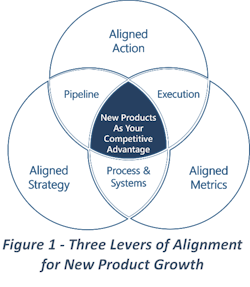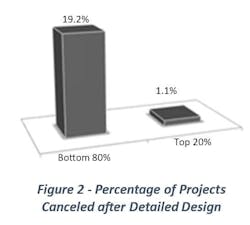Organizational Alignment: The Secret Weapon for Future Growth
Peter Drucker famously declared that any business has two basic functions – marketing and innovation. These functions create business results through growth (i.e., paying customers), and everyone in the organization needs to focus on and contribute to those results.
Sustaining a business requires learning how to balance that focus to deliver growth, both now and in the future. Most successful companies have a handle on today’s growth. But when it comes to future growth through innovation, companies with highly engineered new products struggle.
With long, complex development cycles and a process that involves nearly every part of the organization, it's easy for new product initiatives to get bogged down or underdeliver. By some estimates, only 60% of new products meet their first-year sales targets and go on to be successful.
So what can leaders do to turn that around and make new products into a reliable competitive advantage for future growth? A secret weapon is organizational alignment. Getting everyone pulling in the right direction along these three dimensions:
1. Alignment on Strategy – Moving from products based on internally driven ideas and me-too reactions to competitors to new products built on deep insights into unmet market needs.
2. Alignment on Action – Moving from everyone being too busy with the trivial many to synchronized engagement on the critical few.
3. Alignment on Metrics – Moving from sub-optimization at the silo level to company-wide success through cross-functional collaboration.
We’ve found it easiest to put that kind of alignment to work by focusing on three leverage areas: Pipeline, Execution and Process & Systems.
Lever 1 - Pipeline
The first alignment lever is governance over what makes it into your new product pipeline. To underscore the importance of this, a study from the electronics industry revealed that the top 20% of companies shared a critical difference from the rest of their competitors. They canceled only 1% of projects during development. Yet they canceled the same overall percentage of projects as the bottom 80% canceled – around 19%.
Though not recently updated, this study highlights the timeless 80/20 principle, where most profits come from a small part of the industry—a pattern likely intensified by consolidation over the last 20 years.
How is that possible? The difference was that these top performers excelled at killing bad product ideas early and then refocusing those resources on winners. These companies also earned more than double the EBIT of the other 80% of companies in their industries.
What we can learn from this is that new product governance is a powerful growth enabler. It proactively supports the best opportunities at the expense of the bad and even mediocre ones.
To put this kind of governance in place, here are some tough questions that you need to make sure are being asked during deep-dive conversations:
1. Is it on strategy? Does the opportunity fit your strategy, capabilities and market position? Have you made it clear what you will not do?
2. Do you have the right to win? Will the product leverage your strengths to create more value in your core market? Or help you move into adjacent markets or technologies? Is it more of a stretch than you are ready for?
3. What’s it worth when you do? Before development begins, will the project deliver outstanding value—first in terms of the ROI/payback that buyers will see, and then in terms of ROI for your company? Or will your sales forecasts erode as you get closer to launch?
4. What’s your backup? Have you built the necessary learning loops into your process so teams can move forward with confidence or learn a fast lesson and quickly move on to greener pastures? Have your teams thought about what could go wrong and where they might meet resistance to change? Yes, every new product is a change that customers have to welcome.
Lever 2 - Execution
The second alignment lever is execution, where the ideal is “Focus and Finish.” In a study by Wheelright and Clark, spreading engineers across too many programs resulted in a nearly 50% loss in the amount of work they got done.
The most important thing you can do to accelerate execution and new product revenue is to limit the number of programs underway at any time. It may be counterintuitive. But focus your organization on fewer things, and you'll get more across the finish line—with each launch delivering significantly more value.
Of course, some within your organization may scoff at this as being "just" common sense. The key question is whether it is also common practice. Here are some questions you can use to assess that:
1. Do you have the right number of opportunities in flight to maximize flow? Or are people constantly jumping back and forth between programs? Are programs frequently idle, while resources are pulled off for firefighting on other programs?
2. Is your execution resilient? Does your pipeline use a backlog to keep work flowing smoothly and avoid chaos by staying under 80% utilization?That’s true agility!
3. Are you prioritizing work on the highest-impact opportunities? FIFO (first-in first-out) may work for inventory management, but it's a bad way to set priorities for limited resources. Instead, you should force rank every opportunity on your backlog based on return per unit of effort. That focuses efforts on the highest-impact programs while the lower-impact ones continue to get pushed down the list.
4. Does your organization learn from successes and failures? Are your teams taking time to reflect on key learnings in frequent after-action reviews? Or are they too busy for retrospectives?
A leader we worked with in the industrial steam generation equipment market put this strategy into place for their business. By working on less to finish more, their time-to-revenue dropped from two to three years to ten to 18 months. Within a year, they launched more successful new products than they had in the previous three years combined, while also reducing waste on annual development costs by over $1 million.
Lever 3 – Processes and Systems
The final lever is effective processes and systems to support governance and execution. Processes that go well beyond traditional stages and gates with true digital workflow and data interconnection linking project, portfolio and product. Systems that put real-time information and feedback in the hands of people doing the work.
Here are some essential questions to understanding how your processes stack up:
1. Does your planning and resource management process build commitment? Or do people see due dates as unrealistic or perhaps even punitive? Does your PMO build the plans by themselves? Or do they facilitate the cross-functional planning essential to realistic plans with high buy-in?
2. Are your teams getting an early warning on new-product problems? Does everyone have a real-time view of what’s been accomplished and what still needs attention? Or do you have so much going on that it's hard to keep track? Is everyone clear on their roles and responsibilities? Do you use short daily meetings to focus the team’s attention on execution, instead of wasting time chasing updates and holding replanning meetings?
3. Are you tracking delivery with metrics aligned across functions? Are your product teams taking corrective action to ensure each new product delivers its potential? Do they own the financial results of their programs? Does every function involved have new product metrics in their scorecard, with leading indicators designed to help course-correct early? Is there a clear way to resolve conflicting goals between functions?
4. Do you have the right talent up and down the organization? Since these levers help you define the skills and competencies needed for success, they also help with talent management in terms of hiring and development.
These three levers are not just instruments of alignment; they also play a pivotal role in shaping your organizational culture, transforming it into a place where commitment, collaboration, and engagement flourish.
About the Author
Mike Dalton
Managing Director
Mike Dalton is the founder of Guided Innovation Group, where for nearly 20 years he has helped leaders in highly engineered product companies make new products a reliable competitive advantage. He has contributed numerous Industry Week articles and is the author of Unlocking Innovation Productivity and Simplifying Innovation.


